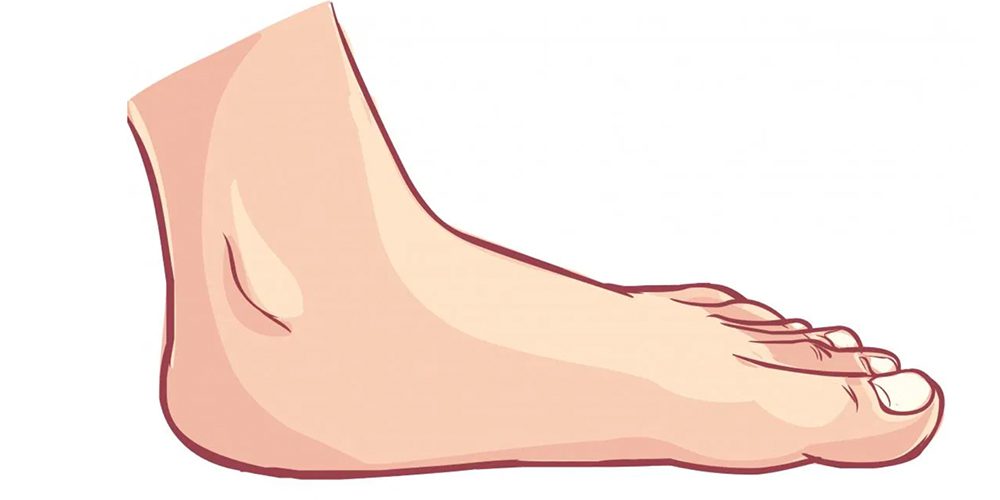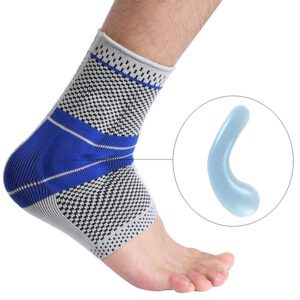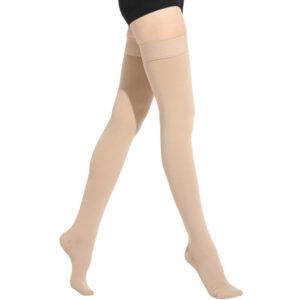You may be experiencing a burning pain on top of the foot. This is not unusual, and in most cases, it’s nothing to worry about. Burning pain on top of the foot can be caused by a number of conditions that are usually treatable with conservative methods like rest and ice packs. That said, if you’re experiencing this type of pain for more than two days or it is accompanied by redness or swelling in the area then see your doctor as soon as possible because you may have an infection or other condition that requires treatment. In any case, make sure to get checked out so you can get relief from your discomfort.
Causes and Symptoms of burning pain on top of the foot
When it comes to burning pain on top of the foot, there are many possible causes. And different symptoms too. Here are the top causes and symptoms that lead to pain on top of your foot:
Overuse
Overuse caused by repeating the same motion with your foot over and over again is the number one reason why the top of your foot might hurt. Jumping, running or kicking a ball can put a lot of stress on the fragile structure of bones, ligaments, tendons and muscles. Conditions caused by overuse include:
Stress Fractures. A stress fracture is the result of tiny cracks in your bones. If you keep pounding on your bones, the damage continues to grow until you have a full-blown break. Excessive force can impact any bone, but most often it affects one of our weight-bearing bones like the metatarsals that lead down to your foot.
Tendonitis. The tendons in your foot are what connect your muscles to the bone. These tendons will often become inflamed if you push yourself too hard or do something repetitive that puts a lot of stress on them, like running for exercise. If you have tendonitis, the top of your foot might feel sore and stiff.
Sinus Tarsi Syndrome. The sinus tarsi is a small channel filled with fluid. If this area gets inflamed it can cause your foot to hurt at the front of your ankle just below your little toe.

Injuries
Even if you’re careful with your foot, you can still end up injuring the top of it. Below are some common injuries that could cause this type of pain:
Lisfrank or mid-foot injury. If the middle foot bone breaks or a tendon inflames, this can cause severe pain on top of your foot.
Fracture of the fifth metatarsal. The pain caused by a fracture of the fifth metatarsal is usually located a bit on the outside of the top of your foot. These conditions need medical care immediately and require a lot of rest, ice and immobilization as treatment.
Cysts. Cysts can develop on top of the foot, especially after an injury. A typical form is a Ganglion Cyst, a small bump filled with fluid that forms directly under the skin on top of the foot. If these cysts presses against the bone or muscles, it can cause pain. A tingling or burning sensation is often the result of a cyst pressing on the nerve.
Severe disorders, conditions or diseases
Unfortunately, pain on top of your foot can be a signal for some really severe conditions. So if you’re sure that your burning pain can’t come from an injury or overuse because your simply not exercising, engaging in sports or other physical activities, you definitely want to consult a podiatrist or your doctor for further diagnosis. Here are some severe conditions that might cause burning pain on top of the foot.
Diabetic Neuropathy. A condition that can develop in patients with diabetes, diabetic neuropathy causes nerve damage which leads to pain and numbness in the extremities. If you have this condition you might feel burning along with your other symptoms.
Diabetic neuropathy is oftentimes the result of years of uncontrolled sugar consumption, being overweight or alcohol and cigarette misuse.
When the nerve damage hits the feet or legs, it’s called peripheral neuropathy, the most common type of diabetic neuropathy. Along with sharp, burning pain, numbness and tingling are the two other frequent symptoms.
This condition requires immediate medical attention. If you have high blood sugar or diabetes and experience any of those symptoms, be sure to check this with your doctor as fast as possible!
Small fiber sensory neuropathy. Another type of neuropathy, but this type doesn’t involve diabetes in most cases. If you experience a loss of feeling in your feet in combination with sharp bursts of pain, SFSN could be the reason.
Alcoholic neuropathy. As the name suggests, this type of neuropathy is caused by consuming too much alcohol. Heavy alcohol consumption can cause severe and irreversible nerve damage.
Morton’s Neuroma. This painful condition is caused by the inflammation of the lining of the nerve. Pain often strikes between the second and third or third and fourth toe and usually gets worse when wearing too-tight footwear.
Charcot-Marie-Tooth disease. This genetic, progressive condition is the most inherited nerve disease that affects the nerves controlling the muscles. The first symptoms include burning feet or a feeling as if a thousand needles were placed into the skin.
Tarsal Tunnel Syndrome. The Tarsal Tunnel is located on the inside of the ankle and functions as a pathway for many arteries, nerves and veins. Flat feet, cysts, spurs or inflamed tendons can compress or entrap this tunnel producing neural symptoms, including burning.
Complex regional pain syndrome. This syndrome most often occurs after an injury or surgery and describes nerve damage that affects signaling from the brain and spine.
Traumatic Nerve Damage through injury. Traumatic injuries can not only damage the muscles and tendons. Nerves can get damaged too. The trauma can have a direct impact as a cause, such as dropping something on your foot or falling or a more complex injury of the spine.
Erythromelalgia. Though this is a very rare case, it still needs to be mentioned at this point. The cause is not known in most cases, but we do know that the pain worsens with exercise, walking and standing.
Malnutrition. Malnutrition was a very common reason for burning feet in the past. Luckily, nutrition has become less of a problem in our modern world and only people in certain regions of the world show nerve damage through it. In the elderly, nerve damage can still be a thing and is most often related to vitamin B deficiencies. Vitamin B deficiencies can cause muscle coordination problems as well besides burning sensation.
Athlete’s Foot. This infection can be a cause for burning feet. The fungus that causes Athlete’s foot, Tinea pedis, thrives in hot and humid conditions and can easily be transmitted through shoes or even shower mats.
The fungal infection causes severe itching cracking of the skin with possible bleeding which leads to inflammations. This is very common on the feet but can be found on the hands as well.
Hypothyroidism. Besides burning feet, fatigue, dry skin and weight gain are other symptoms of this condition that is caused by hormone changes in your body.
Kidney diseases. Kidneys play an important role in keeping your blood clean. When they stop working correctly, toxins can enrich in your blood. Burning feet are only one of the mildest symptoms.
Peripheral artery disease. When your arteries are narrowed, this can lead to a burning sensation in your feet as well. Symptoms are similar to peripheral neuropathy.
Exposure to toxins. Heavy metals and other industrial chemicals can cause severe nerve damage in your body. Specific medications to treat some conditions like HIV, for example, can also cause nerve damage. So please make sure to get your blood checked regularly by your doctor.
Infectious diseases. HIV, Lyme disease or syphilis can cause burning feet. If you think you might have an infection, ask your doctor to get tested as fast as possible to rule out these bad diseases.
Diagnosis of burning pain on top of the foot
We recommend that you see your doctor when you experience severe pain that stops you from being active or if the pain gets worse with time. If you tried some home remedies for about two weeks without any success, consult a doctor or podiatrist for further examination.
If you feel dizzy, sick, lose control over your feet or feel unable to walk, please visit an urgent care center immediately or call 911.
As usual, your visit to your doctor’s office starts with a physical exam and a lot of questions. Your doctor will check you for structural problems with your feet and legs, fungal infection, lack of feeling and sensation and test your reflexes.

Besides applying pressure to various parts of your feet and legs, your doctor will test your range of motion and will likely ask you to do some exercises to see your body in motion. Since diabetes is the most common cause for burning feet, a test for diabetes is most often done as well.
If a bone spur, fraction or condition like Tarsal Tunnel Syndrome is suspected, your doctor will certainly order X-rays or MRI scans.
To rule out infections, kidney diseases or nutritional deficiencies, blood tests are made.
If you have a medical history or already take medications regularly, this can be valuable information for your doctor and he will ask you for this type of information during the exam. Don’t be ashamed of anything and answer all of his questions as precisely as you can be.
Treatment options and home remedies for burning feet
Treatment options highly depend on the diagnosis. In some cases, it is enough to change shoes or use anti-fungal prescriptions for some time. Shoe inserts and orthotics can be a very good help to make walking and standing a lot more comfortable.
Vitamin B and thyroid supplements are good ways to support your body with the necessary nutrition. And if diabetes is involved, you may need to change your complete diet. Additionally, your doctor might prescribe some drugs to help with nerve pain.
And then there are some awesome foot care home remedies that you should consider.
- Cold water or ice foot baths. Soaking your feet in cold water or ice baths for a few minutes helps with inflammation and reduces burning sensations.
- Turmeric. Turmeric is known to reduce inflammation in the body. And many people report great success with neurological symptoms getting a lot better. The curcumin within turmeric also helps ease nerve pain. So it’s well worth including turmeric in your diet.
- Foot massage. The feeling that we get when someone else cares for our feet and rubs them feels so good. And foot massage can actually help with nerve pain as well.
- Baking soda and vinegar. These ingredients are natural anti-inflammatories and will certainly ease the burning sensation on your feet if you give them a try. The baking soda+vinegar foot spa is done by mixing one part of baking soda and two parts of vinegar. You can also add a couple drops of lavender oil to the mixture. Let this foot bath sit for 15 minutes and rinse your feet with cool water afterward. And make sure not to use baking soda on its own, as it’s way too harsh for the skin on your feet.
- If you plan to exercise, don’t rush it too soon. Gradually raise the intensity and listen to your body. If you need to, rest for longer periods and more often.
- Warm-up your feet and legs properly before exercise. Once your muscles get warm, do some stretching exercises.
- Wear compression socks, sleeves or a splint at home. This not only gives your feet the rest they need, but it also improves blood circulation and prevents swelling.
- Physical therapy is your friend. This is especially good for tendinitis, peripheral neuropathy or peroneal nerve damage.
A final note
Burning pain on the top of your foot can be a sign that something is wrong. If you are experiencing this type of pain, see a podiatrist as soon as possible to get an accurate diagnosis and start treatment. The article has given many good tips for how to treat burning feet – from home remedies like ice baths or turmeric to more traditional treatments such as physical therapy. In some cases, it may just be necessary to change shoes or use anti-fungal prescriptions for some time until symptoms subside completely. You should also wear compression socks at home if you have any nerve damage in order to give your feet relief from their constant discomfort. There’s no need to suffer from burning sensations when there are so many ways available now!





















